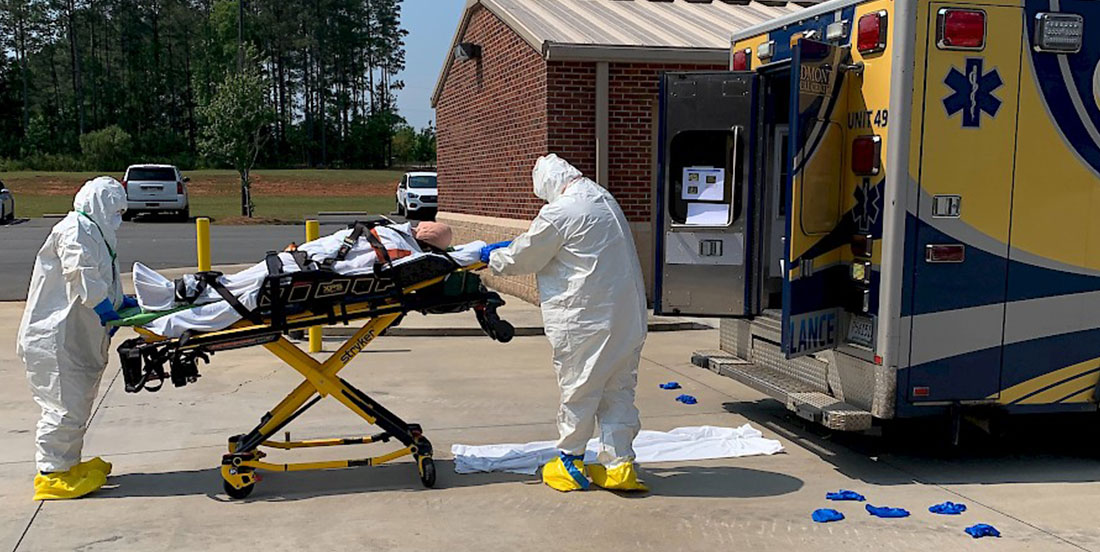- Articles, CBRNE, Critical Infrastructure, Emergency Management, Emergency Medical Services, Fire, Hazmat, Hospitals, Military, Public Health, Science & Technology, Transportation
- Ron Cain
It seems that every day over the past two years there are plenty of news stories covering the strain hospitals are facing in staffing shortages and the impacts from a global pandemic. Emergency medical services (EMS) are also dealing with their own similar issues across the nation. Many of these critical facilities and services are located in the proximity of nuclear power plants in which previous agreements were established to provide treatment, patient transportation, radiation monitoring, and decontamination in the event of a patient-generating event within a nuclear power plant’s emergency planning zones.
Biennially, the Federal Emergency Management Agency (FEMA) grades Medical Services Drills (MSD) and requires training in the off year for designated hospitals and EMS systems. FEMA requires radiation response teams in both hospital and prehospital organizations with specialized training. It is possible due to the combination of staffing shortages and pandemic impacts that a gap in radiation emergency preparedness could lead to life-threatening problems that are much worse that a negative drill finding from FEMA.
A Solution for Meeting Training Requirements
A state level emergency management agency in the Southeast recently addressed these potential issues after it revised the MSD training it offers to hospitals and EMS systems. During a rehearsal of concept (ROC), the scenario included a county emergency management department in coordination with an affected hospital requesting state level training support for new emergency department staff with no previous radiation emergency experience or training.
The training content provided during the ROC included the following:
- Oak Ridge Institute for Science and Education’s Radiation Assistance Center/Training Site (REAC/TS) standards are emphasized throughout the training. REAC/TS is considered the gold standard for radiation emergency medical treatment and patient decontamination.
- Training content focused on new and/or inexperienced EMS and hospital staff with didactic and practical learning outcomes.
- Reminder that the ongoing global pandemic has created some similarities in response and management of radiation emergencies for EMS and hospital responders and clinicians.
- Emphasis on the partnership between local EMS, hospitals, local, state, and federal level emergency management organizations.
- Comparisons and contrasts between a medical services drill and a real radiation emergency incident.
A didactic presentation was followed by practical training on dosimetry, patient monitoring, how to use detection instruments, patient packaging for EMS transport, and patient decontamination. This usually lasts two hours but can go longer depending on class size. No virtual option was available due to the critical need to teach the above listed skills in person for better learning outcomes.

Like many other issues the global pandemic has exposed, radiation emergency preparedness could become a vulnerability itself – if it has not already. The ROC scenario included a mix of travel nurses, new employees, and staff members that transferred from other hospital departments – all with no combined experience in radiation emergency medicine or in patient decontamination. With a graded MSD in the future and a gap in their preparedness, outside help in the form of state level training support was requested by the local emergency management agency.
A state level emergency management agency in the Southeast recently addressed potential issues related to a radiation emergency using a rehearsal of concept (ROC).
REAC/TS offers excellent training at its site in Oakridge, Tennessee. The nuclear energy companies coordinate and support the attendance of hospital, EMS, and emergency management professionals that are involved in radiation emergency preparedness, but the courses seem to fill fast. In addition, like many other teaching institutions in the past two years, they have canceled in-person classes due to the pandemic. Subsequently and realistically, the option was not in the ROC scenario to send hospital and EMS employees to REAC/TS.
Key Takeaways From the ROC
With all the aforementioned issues with EMS and hospitals, the ROC included a discussion about the realities of an MSD versus real events:
- FEMA requires the demonstration of one patient for treatment, transportation, monitoring, and decontamination during its graded MSDs. In reality, there may be many patients calling EMS or driving themselves to the hospital.
- Nuclear power plant emergencies tend to develop slowly, and the hospital and community may have activated their emergency plans days before the first potentially contaminated patient arrives. Incident management for extended times should be considered.
- EMS and hospitals should evolve their radiation emergency planning for multiple patient transports from within contaminated zones and establish robust personal protective equipment resupply lines. Radiation emergencies, unlike a viral pandemic, can be rapidly detected using dosimetry and radiation monitoring instruments that are stockpiled in nuclear power plant emergency planning zones.
- Actual nuclear power plant emergencies will require the partnerships between local, state, and federal agencies who should already be coordinating well before any exercise or actual incident.
Trained radiation response teams that exist today could be non-existent tomorrow due to the staff turnover and other factors related to the global pandemic. This will negatively impact two of FEMA’s community lifelines – the Health and Medical and the Energy (Power & Fuel) – and potentially impact even more community lifelines as the incident grows. The ROC scenario was built with these critical issues in mind.
While it is still important for EMS systems and hospitals to pass FEMA-graded medical services drills, it is far more important to adapt to the constantly changing operational environment and to continue to be prepared for real radiation emergencies that threaten the life safety of communities, however unlikely they may be.

Ron Cain
Ron Cain is a radiological emergency preparedness coordinator for a state emergency management agency. He has previous experience as a hospital and small county emergency manager. He has over 25 years of experience as a paramedic in county, military, and private EMS systems. He is a graduate of the National Fire Academy’s EMS Special Operations and Advanced Life Support for Hazardous Materials Incidents Course and a graduate from the REAC/TS Radiation Emergency Medicine Course. He is a state certified emergency manager and has earned undergraduate and graduate degrees in disaster and emergency management.
- Ron Cainhttps://domesticpreparedness.com/author/ron-cain
- Ron Cainhttps://domesticpreparedness.com/author/ron-cain






